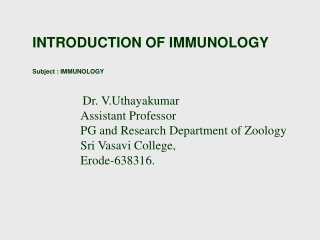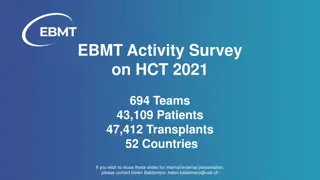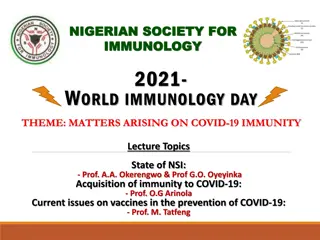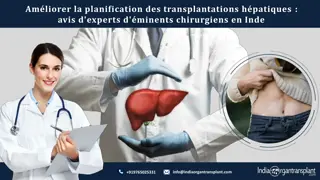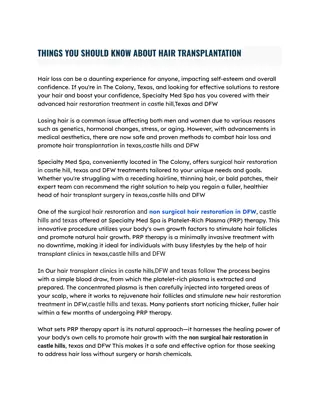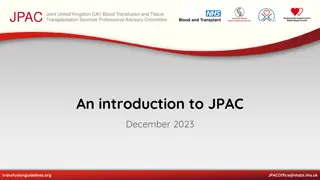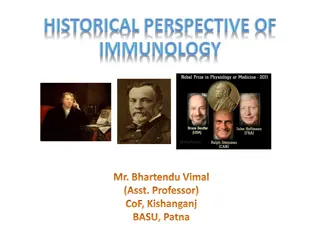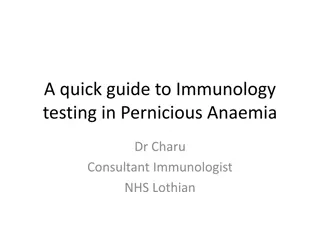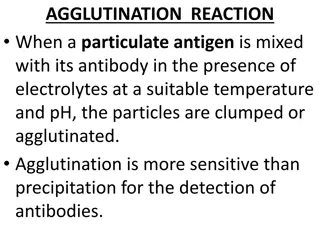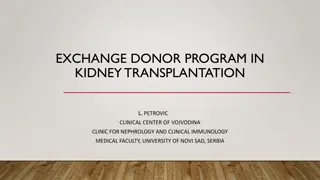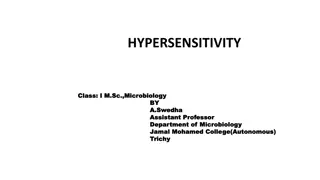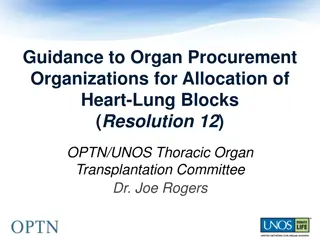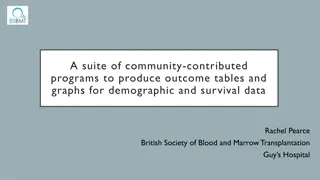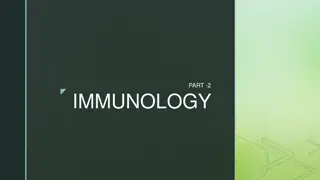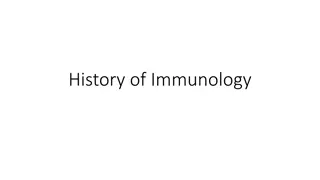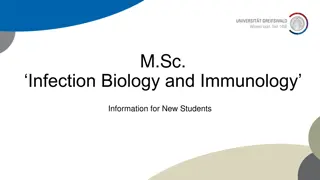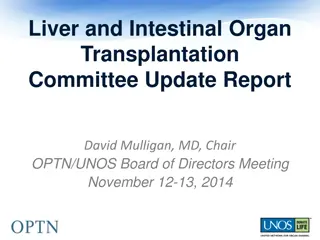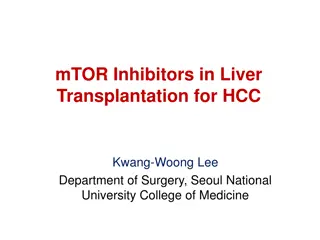Transplantation Immunology
Learn about histocompatibility systems, alloantigen recognition, graft types, graft rejection mechanisms, graft-versus-host disease risk factors, HLA typing methods, and detecting HLA antibodies in clinical transplantation. Explore hyperacute and acute rejection episodes, their immunological mechanisms, and diagnostic criteria for effective treatment and improved graft survival.
Download Presentation

Please find below an Image/Link to download the presentation.
The content on the website is provided AS IS for your information and personal use only. It may not be sold, licensed, or shared on other websites without obtaining consent from the author.If you encounter any issues during the download, it is possible that the publisher has removed the file from their server.
You are allowed to download the files provided on this website for personal or commercial use, subject to the condition that they are used lawfully. All files are the property of their respective owners.
The content on the website is provided AS IS for your information and personal use only. It may not be sold, licensed, or shared on other websites without obtaining consent from the author.
E N D
Presentation Transcript
Transplantation Immunology Part II Assis . Prof. Dr. Refif S. Al- Shawk 2023-2024
LEARNING OUTCOMES After finishing this lecture, you should be able to: 1. List the histocompatibility systems relevant to clinical transplantation. 2. Compare the mechanisms of direct and indirect alloantigen recognition. 3. Distinguish between an allograft, autograft, xenograft, and syngeneic graft (isograft). 4. Compare the immunologic mechanisms involved in hyperacute, acute, and chronic graft rejection. 5. Identify risk factors for graft-versus-host disease (GVHD). 6. You should know the laboratory methods for human leukocyte antigen (HLA) typing. 7. Describe laboratory methods for detecting and identifying HLA antibodies (i.e., antibody screening, identification, and crossmatching).
Patterns and Mechanisms of Allograft Rejection Rejection episodes vary in the time of occurrence and the effector mechanism that is involved. 1. Hyperacute Rejection: occurs within minutes to hours after the vascular supply to the transplanted organ is established (in some cases, rejection may occur in an accelerated fashion several days after transplant and has been referred to as accelerated vascular rejection). This type of rejection is mediated by preformed antibody that reacts with donor vascular endothelium. ABO, HLA, and certain endothelial antigens may elicit hyperacute rejection. Antibodies to these antigens may be present because of blood transfusion, prior transplantation, or exposure of a pregnant woman to fetal antigens of paternal origin. Immunological mechanisms: Binding of preformed antibodies to the alloantigens activates the complement cascade and clotting mechanisms and leads to thrombus formation. The result is ischemia and necrosis of the transplanted tissue. Hyperacute rejection is rarly encountered in clinical transplantation. Donor and recipient are chosen to be ABO identical or compatible, and patients awaiting transplantation are screened for the presence of preformed HLA antibodies. In addition, the absence of donor HLA-specific antibodies is confirmed before transplant by the performance of a crossmatch test. These approaches have virtually eliminated hyperacute rejection episodes.
Transplant Rejection 2. Acute Rejection: Days to months after transplant, individuals may develop acute rejection (AR). AR can be mediated by a cellular alloresponse (ACR) or by donor-specific antibody (also known as antibody-mediated response; AMR). Immunological mechanisms: ACR is characterized by parenchymal and vascular injury. Interstitial cellular infiltrates contain a predominance of CD8+ T cells as well as CD4+ T cells and macrophages. CD8 cells likely mediate cytotoxic reactions to foreign MHC-expressing cells, whereas CD4 cells likely produce cytokines and induce DTH reactions. Antibody may also be involved in acute graft rejection by binding to vessel walls and activating complement. The antibody induces transmural necrosis and inflammation as opposed to the thrombosis typical of hyperacute rejection. Diagnostic criteria include characteristic histological findings, deposition of the complement protein C4d in the peritubular capillaries, and detection of donor-specific HLA antibody. The development and application of potent immunosuppressive drugs that target multiple pathways in the immune response to alloantigens has improved early graft survival of solid-organ transplants by reducing the incidence of AR and by providing approaches for its effective treatment.
Transplant Rejection 3. Chronic rejection: results from a process of graft arteriosclerosis characterized by progressive fibrosis and scarring with narrowing of the vessel lumen caused by proliferation of smooth muscle cells. Chronic rejection remains the most significant cause of graft loss after the first year post-transplant because it is not easily treatable. Several predisposing factors affect the development of chronic rejection, including prolonged cold ischemia, reperfusion injury, AR episodes, and toxicity from immunosuppressive drugs. Chronic rejection is also thought to have an immunologic component, presumably a DTH reaction to foreign HLA proteins. Immunological mechanisms: studies support the important role for CD4 T cells and B cells in this process. Cytokines and growth factors secreted by endothelial cells, smooth muscle cells, and macrophages activated by IFN gamma stimulate smooth muscle cell accumulation in the graft vasculature. Alloantibody production likely contributes to the development of chronic rejection as well.
Patterns and Mechanisms of Allograft Rejection Abbas, Abul K.; Lichtman, Andrew H.; Pillai, Shiv. Cellular and Molecular Immunology E-Book . Elsevier Health Sciences. Kindle Edition
Graft-Versus-Host Disease (GVHD) Hematopoietic cell transplants (HCT) (and less commonly lung and liver transplants) are complicated by a unique allogeneic response GVHD. In this condition, lymphoid cells in the graft mount an immune response against the host s histocompatibility antigens. Recipients of HCT transplants for hematologic malignancies typically have depleted bone marrow before transplantation because of the chemotherapy used to treat the malignancy and make room for incoming stem cells to repopulate the marrow. The individual receives an infusion of donor bone marrow or, more commonly, peripheral blood stem cells. The infused products often contain some mature T cells. These cells have several beneficial effects, including reconstitution of immunity, and mediation of a Graft-Versus-Leukemia (GVL) effect. However, these mature T cells may also mediate GVHD.
Graft-Versus-Host Disease (GVHD) Acute GVHD occurs during the first 100 days post-infusion and manifests in the skin, gastrointestinal tract, and liver. In mismatched allogeneic stem cell transplantation, the targets of GVHD are the mismatched HLA proteins, whereas in matched stem cell transplantation, mHAs are targeted. Immunologically what happened? The infused T cells can mediate GVHD in several ways, including a massive release of cytokines because of large-scale activation of the donor cells by MHC- mismatched proteins and by infiltration and destruction of tissue. The recipient s medical team can take several approaches to reduce the incidence and severity of GVHD, including immunosuppressive therapy in the early post-transplant period and removal of T lymphocytes from the graft (HOW?). T-cell reduction, achieved by purification of donor hematopoietic cells from the peripheral blood or bone marrow collection, is very effective in lowering the incidence of GVHD, but it can also reduce the GVL effect of the infused cells and increase the incidence of graft failure. The GVL effect is similar to the GVH response but targets the recipient s malignant cells as opposed to healthy tissues of the recipient, such as the skin and gastrointestinal tract. Beyond 100 days post-transplant, patients may experience chronic GVHD. This condition resembles autoimmune disease, with fibrosis affecting the skin, eyes, mouth, and other mucosal surfaces.
Clinical Histocompatibility Testing HLA typing and HLA antibody screening and identification is important in graft survival HLA typing is the identification of the HLA antigens (phenotype) or genes in a transplant candidate or donor. For clinical HLA testing, phenotypes or genotypes of the classical transplant antigens or genes are determined (HLA-A, HLA-B, HLA-C, HLA-DR, HLA-DQ, HLA- DP). HLA phenotyping : The classic method of HLA phenotyping is the complement-dependent cytotoxicity test (CDC), in which HLA antigens are typed by incubating the individual s lymphocytes with a panel of antisera and reagent complement. Positive cells are identified by their ability to bind specific antisera and complement, resulting in membrane permeabilization and uptake of vital stains. HLA genotype: Molecular HLA genotyping methods use polymerase chain reaction (PCR)-based amplification of HLA genes followed by analysis of the amplified DNA to identify the specific HLA allele or allele group. Screening and identification of preformed HLA antibodies: in transplant recipients can be performed by the CDC method through incubation of patient serum with panels of lymphocytes with known HLA antigens. Crossmatching: is performed by incubation of recipient serum with donor lymphocytes in a CDC assay to confirm the absence of donor-specific antibody.
Principle of the complement-dependent cytotoxicity (CDC) test A. Addition of patient lymphocytes to well containing specific HLA antisera Addition of reagent complement Addition of vital dye Scoring of results B. C. D. Miller, Linda E; Stevens, Dorresteyn Christine. Clinical Immunology & Serology A Laboratory Perspective Fifth Edition. 2021
References Miller, Linda E; Stevens, Dorresteyn Christine. Clinical Immunology & Serology A Laboratory Perspective (p. 298). F.A. Davis Company. Fifth Edition. 2021 Kindle Edition. Abbas, Abul K.; Lichtman, Andrew H.; Pillai, Shiv. Cellular and Molecular Immunology E-Book (p. 393). Elsevier Health Sciences. Tenth Edition. 2022. Kindle Edition.


